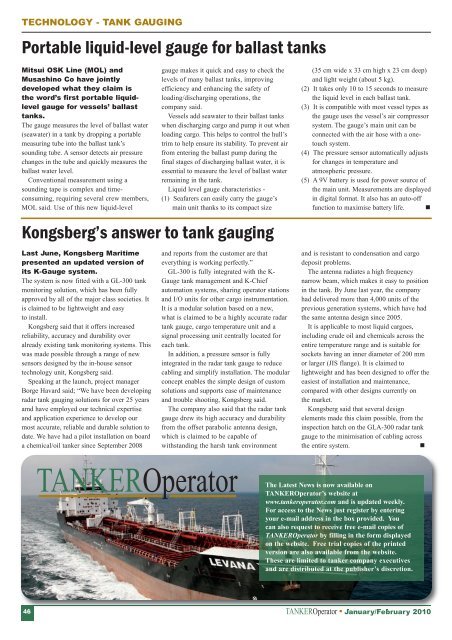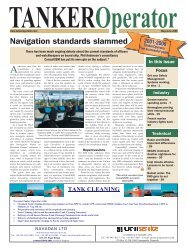Download - Tanker Operator
Download - Tanker Operator
Download - Tanker Operator
Create successful ePaper yourself
Turn your PDF publications into a flip-book with our unique Google optimized e-Paper software.
TECHNOLOGY - TANK GAUGING<br />
Portable liquid-level gauge for ballast tanks<br />
Mitsui OSK Line (MOL) and<br />
Musashino Co have jointly<br />
developed what they claim is<br />
the word’s first portable liquidlevel<br />
gauge for vessels’ ballast<br />
tanks.<br />
The gauge measures the level of ballast water<br />
(seawater) in a tank by dropping a portable<br />
measuring tube into the ballast tank’s<br />
sounding tube. A sensor detects air pressure<br />
changes in the tube and quickly measures the<br />
ballast water level.<br />
Conventional measurement using a<br />
sounding tape is complex and timeconsuming,<br />
requiring several crew members,<br />
MOL said. Use of this new liquid-level<br />
gauge makes it quick and easy to check the<br />
levels of many ballast tanks, improving<br />
efficiency and enhancing the safety of<br />
loading/discharging operations, the<br />
company said.<br />
Vessels add seawater to their ballast tanks<br />
when discharging cargo and pump it out when<br />
loading cargo. This helps to control the hull’s<br />
trim to help ensure its stability. To prevent air<br />
from entering the ballast pump during the<br />
final stages of discharging ballast water, it is<br />
essential to measure the level of ballast water<br />
remaining in the tank.<br />
Liquid level gauge characteristics -<br />
(1) Seafarers can easily carry the gauge’s<br />
main unit thanks to its compact size<br />
Kongsberg’s answer to tank gauging<br />
Last June, Kongsberg Maritime<br />
presented an updated version of<br />
its K-Gauge system.<br />
The system is now fitted with a GL-300 tank<br />
monitoring solution, which has been fully<br />
approved by all of the major class societies. It<br />
is claimed to be lightweight and easy<br />
to install.<br />
Kongsberg said that it offers increased<br />
reliability, accuracy and durability over<br />
already existing tank monitoring systems. This<br />
was made possible through a range of new<br />
sensors designed by the in-house sensor<br />
technology unit, Kongsberg said.<br />
Speaking at the launch, project manager<br />
Borge Havard said; “We have been developing<br />
radar tank gauging solutions for over 25 years<br />
amd have employed our technical expertise<br />
and application experience to develop our<br />
most accurate, reliable and durable solution to<br />
date. We have had a pilot installation on board<br />
a chemical/oil tanker since September 2008<br />
and reports from the customer are that<br />
everything is working perfectly.”<br />
GL-300 is fully integrated with the K-<br />
Gauge tank management and K-Chief<br />
automation systems, sharing operator stations<br />
and I/O units for other cargo instrumentation.<br />
It is a modular solution based on a new,<br />
what is claimed to be a highly accurate radar<br />
tank gauge, cargo temperature unit and a<br />
signal processing unit centrally located for<br />
each tank.<br />
In addition, a pressure sensor is fully<br />
integrated in the radar tank gauge to reduce<br />
cabling and simplify installation. The modular<br />
concept enables the simple design of custom<br />
solutions and supports ease of maintenance<br />
and trouble shooting, Kongsberg said.<br />
The company also said that the radar tank<br />
gauge drew its high accuracy and durability<br />
from the offset parabolic antenna design,<br />
which is claimed to be capable of<br />
withstanding the harsh tank environment<br />
(35 cm wide x 33 cm high x 23 cm deep)<br />
and light weight (about 5 kg).<br />
(2) It takes only 10 to 15 seconds to measure<br />
the liquid level in each ballast tank.<br />
(3) It is compatible with most vessel types as<br />
the gauge uses the vessel’s air compressor<br />
system. The gauge’s main unit can be<br />
connected with the air hose with a onetouch<br />
system.<br />
(4) The pressure sensor automatically adjusts<br />
for changes in temperature and<br />
atmospheric pressure.<br />
(5) A 9V battery is used for power source of<br />
the main unit. Measurements are displayed<br />
in digital format. It also has an auto-off<br />
function to maximise battery life. <br />
and is resistant to condensation and cargo<br />
deposit problems.<br />
The antenna radiates a high frequency<br />
narrow beam, which makes it easy to position<br />
in the tank. By June last year, the company<br />
had delivered more than 4,000 units of the<br />
previous generation systems, which have had<br />
the same antenna design since 2005.<br />
It is applicable to most liquid cargoes,<br />
including crude oil and chemicals across the<br />
entire temperature range and is suitable for<br />
sockets having an inner diameter of 200 mm<br />
or larger (JIS flange). It is claimed to<br />
lightweight and has been designed to offer the<br />
easiest of installation and maintenance,<br />
compared with other designs currently on<br />
the market.<br />
Kongsberg said that several design<br />
elements made this claim possible, from the<br />
inspection hatch on the GLA-300 radar tank<br />
gauge to the minimisation of cabling across<br />
the entire system.<br />
<br />
TANKER<strong>Operator</strong><br />
The Latest ews is now available on<br />
TAKER<strong>Operator</strong>’s website at<br />
www.tankeroperator.com and is updated weekly.<br />
For access to the ews just register by entering<br />
your e-mail address in the box provided. You<br />
can also request to receive free e-mail copies of<br />
TAKER<strong>Operator</strong> by filling in the form displayed<br />
on the website. Free trial copies of the printed<br />
version are also available from the website.<br />
These are limited to tanker company executives<br />
and are distributed at the publisher’s discretion.<br />
46<br />
TANKER<strong>Operator</strong> January/February 2010

















